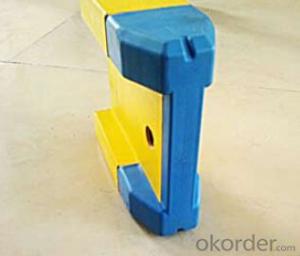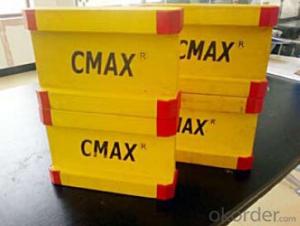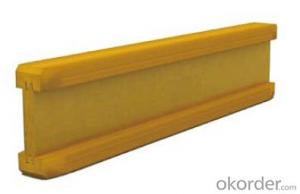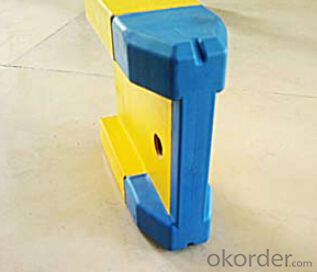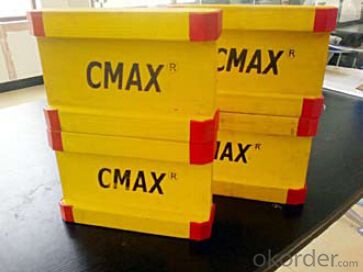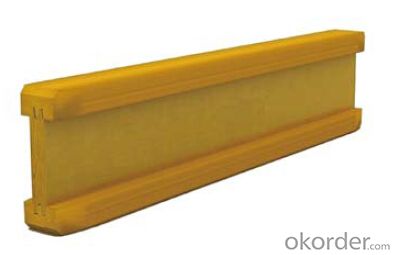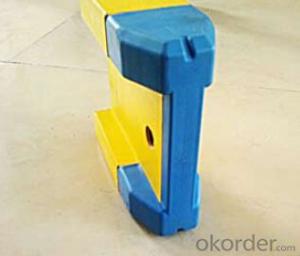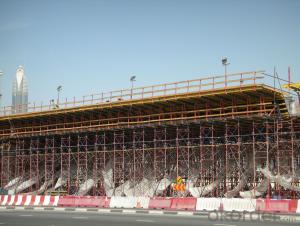Timberbeam Formwork for building Construction
- Loading Port:
- Tianjin
- Payment Terms:
- TT OR LC
- Min Order Qty:
- 50 m²
- Supply Capability:
- 1000 m²/month
OKorder Service Pledge
Quality Product, Order Online Tracking, Timely Delivery
OKorder Financial Service
Credit Rating, Credit Services, Credit Purchasing
You Might Also Like
Characteristics:
◆ Standardized production lines.
Supply capability: 3000m/day, Lmax = 6600mm.
◆ Finger jointing of the flange and web, the strength of timber beam is highly improved.
Max. shearing force failure load:40KN
◆ Well treated to prevent from water penetration or erosion, so the service life maximally
extended.
Normally, CNBM timber beam H20 can be used for 4 to 5 years, the exact using time would
depend on maintenance & storage.
◆ Robust caps at the end of the girders protect against damages.
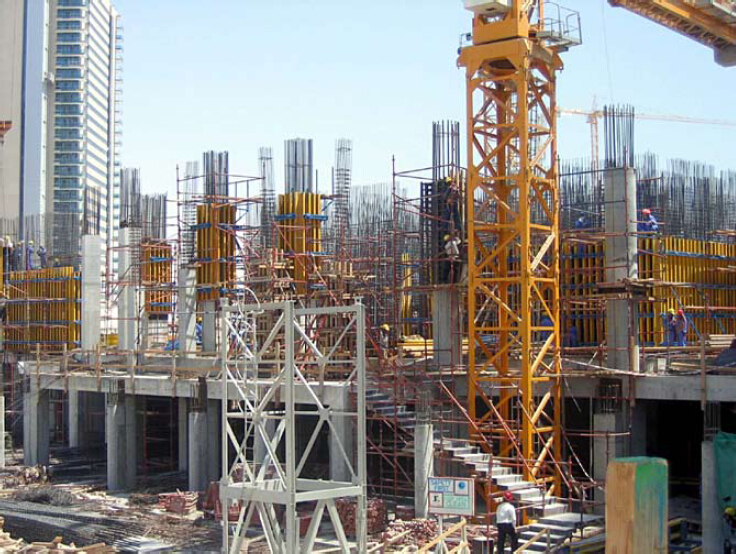
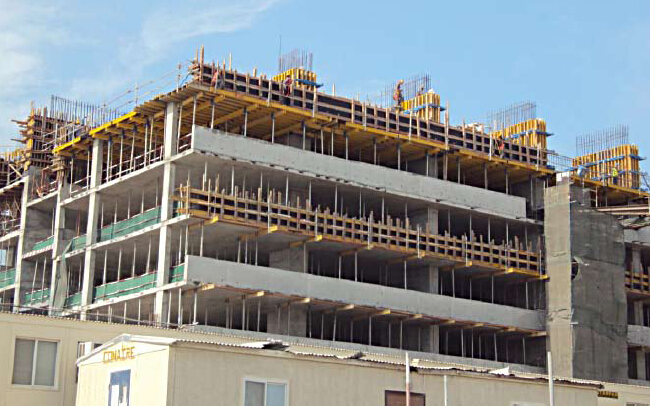
- Q: What are the considerations when designing steel formwork for columns?
- When designing steel formwork for columns, there are several important considerations that need to be taken into account. These considerations include the size and shape of the column, the load it will bear, the height of the column, the desired finish of the concrete, and the availability of labor and equipment. Firstly, the size and shape of the column will determine the dimensions and configuration of the formwork. The formwork needs to be designed to accommodate the specific dimensions of the column, including its diameter or width, and its height. The formwork may need to be adjustable or modular to accommodate different column sizes and shapes. Secondly, the load that the column will bear is an important consideration. The formwork needs to be designed to withstand the weight of the concrete, as well as any additional loads such as construction materials or equipment. It should be able to support the weight without deformation or failure, ensuring the integrity and safety of the structure. The height of the column also needs to be considered when designing the formwork. Tall columns may require additional supports or bracing to prevent buckling or collapsing. The formwork should be designed to provide adequate stability and strength throughout the height of the column. Moreover, the desired finish of the concrete is an essential consideration. If a smooth or architectural finish is desired, the formwork needs to be designed to provide a smooth and even surface. This may require the use of special form liners or coatings to achieve the desired finish. Lastly, the availability of labor and equipment should be taken into account. The design of the formwork should consider the ease of assembly, disassembly, and transportation. It should be practical and efficient to install and dismantle, taking into account the available labor and equipment on the construction site. In summary, when designing steel formwork for columns, considerations should include the size and shape of the column, the load it will bear, the height of the column, the desired finish of the concrete, and the availability of labor and equipment. By carefully considering these factors, the formwork can be designed to meet the specific requirements of the project, ensuring a safe and efficient construction process.
- Q: How does steel formwork prevent concrete honeycombing?
- Steel formwork prevents concrete honeycombing by providing a strong and rigid framework that holds the concrete in place during the pouring and curing process. Honeycombing occurs when there are voids or gaps in the concrete mixture, which can weaken the structural integrity and aesthetics of the final product. Steel formwork is designed to be robust and durable, ensuring that it maintains its shape and prevents any movement or shifting of the concrete. This reduces the risk of air pockets or voids forming within the concrete mixture, which can lead to honeycombing. Additionally, steel formwork is typically made with smooth surfaces that prevent the concrete from sticking to the formwork. This allows for easier removal of the formwork once the concrete has cured, minimizing the chance of any damage or disruption to the concrete surface that could potentially lead to honeycombing. Furthermore, the tight fit and precise alignment of steel formwork help to control the flow and placement of the concrete, ensuring that it fills all the required areas without any gaps or voids. This helps to eliminate potential weak points or areas where honeycombing could occur. Overall, steel formwork provides a reliable and effective solution for preventing concrete honeycombing by offering a sturdy framework, smooth surfaces, and precise alignment that promotes the proper filling and curing of the concrete mixture.
- Q: Can steel formwork be used for precast concrete facades with intricate patterns?
- Yes, steel formwork can be used for precast concrete facades with intricate patterns. Steel formwork is known for its strength and durability, making it suitable for creating complex and detailed designs. The flexibility of steel allows for the creation of intricate patterns, textures, and shapes on the surface of the concrete. Additionally, steel formwork can be easily adjusted and modified to accommodate any desired pattern or design. This makes it a popular choice for precast concrete facades that require intricate patterns or artistic elements. Overall, steel formwork provides the necessary support and versatility to achieve complex designs in precast concrete facades.
- Q: How does steel formwork contribute to the overall aesthetics of a structure?
- Steel formwork, a versatile and durable construction material, plays a vital role in shaping a structure's aesthetics. Its impact on a building's visual appeal is evident in various ways. Firstly, steel formwork enables the achievement of precise and intricate designs. The flexibility and strength of steel empower architects and designers to create complex shapes and unique forms that would be difficult or impossible with other materials. This ability to generate innovative and captivating designs enhances a structure's visual appeal, distinguishing it from its surroundings. Furthermore, steel formwork ensures a smooth and flawless concrete surface. The accurate manufacturing of steel panels guarantees a seamless appearance without any gaps or imperfections. This refined finish enhances the overall aesthetics of the structure, providing it with a sleek and contemporary look. Moreover, steel formwork allows for the creation of larger uninterrupted spans and open spaces. The strength of steel enables the construction of thinner and lighter elements, like slabs and beams, without compromising structural integrity. This characteristic grants architects the freedom to design structures with expansive windows, open floor plans, and abundant natural light. These features not only enhance a building's functionality but also contribute to its aesthetic appeal by creating a sense of spaciousness and connection with the environment. Additionally, steel formwork offers the advantage of reusability, significantly reducing construction waste and environmental impact. This sustainability aspect aligns a structure with modern principles of eco-friendly construction, further enhancing its overall aesthetics. The use of steel formwork demonstrates a dedication to sustainable design practices, increasing the perceived value and attractiveness of a building to potential occupants and investors. In conclusion, steel formwork contributes to a structure's aesthetics through its facilitation of intricate designs, provision of a smooth finish, creation of larger open spaces, and support of sustainable construction practices. Its versatility and durability make it an ideal choice for architects and designers seeking visually appealing and distinct structures.
- Q: What are the different types of edge protections available for steel formwork?
- Different types of edge protections are available for steel formwork, each designed for a specific purpose and offering varying levels of safety and functionality. Here are some common types: 1. Steel edge protection: Constructed from steel, this type is typically used in heavy-duty construction projects. It ensures the safety of workers and prevents accidental falls with its excellent durability and strength. 2. Rubber edge protection: Offering impact resistance and a cushioning effect, rubber edge protection is a lightweight and flexible option. It is commonly used in areas where workers may come into contact with the edge, such as staircases or walkways. 3. Plastic edge protection: Lightweight, easy to install, and cost-effective, plastic edge protection creates a barrier between workers and the edge, preventing slips or falls. It is commonly used in low-risk areas or temporary construction sites. 4. Foam edge protection: Made of soft and flexible material, foam edge protection provides a cushioning effect and prevents injuries from accidental bumps. It is typically used in areas with a lower risk of falls but a higher chance of impact. 5. Metal edge protection: Industrial settings with heavy machinery or equipment often utilize metal edge protection. It offers excellent durability and protection against impact, ensuring the safety of both workers and equipment. 6. Removable edge protection: This type can be easily installed and removed as needed. It is commonly used in areas requiring temporary edge protection, such as during construction or renovation projects. It is crucial to select the appropriate edge protection based on the specific requirements of the construction project, considering factors like risk level, durability, ease of installation, and cost-effectiveness.
- Q: How does steel formwork handle concrete curing compounds and sealers?
- Steel formwork is highly resistant to concrete curing compounds and sealers. Due to its non-porous surface, steel formwork prevents the penetration of these chemicals, ensuring that they do not interfere with the curing process or affect the quality of the concrete. Additionally, steel formwork is easy to clean and maintain, allowing for efficient removal of any residual compounds or sealers that may come into contact with it during construction.
- Q: Can steel formwork be used for both interior and exterior concrete placement?
- Yes, steel formwork can be used for both interior and exterior concrete placement. Steel formwork is known for its durability and strength, making it suitable for various construction projects. It provides a stable and rigid structure that can withstand the pressure and weight of the concrete during the pouring and setting process. Moreover, steel formwork can be easily assembled and disassembled, allowing for efficient use in both interior and exterior applications. Whether it is for building walls, columns, slabs, or other concrete elements, steel formwork offers a versatile solution that can be used in different environments and conditions.
- Q: What are the different types of surface treatments available for steel formwork?
- There are several different types of surface treatments available for steel formwork, each offering its own unique benefits and characteristics. 1. Galvanization: This is a popular surface treatment method where a layer of zinc is applied to the steel formwork. Galvanization helps protect the steel from corrosion, extending its lifespan and enhancing its durability. It can also provide a smoother surface finish. 2. Powder coating: Powder coating involves applying a dry powder to the surface of the steel formwork, which is then heated to create a durable and protective layer. This treatment offers excellent resistance to corrosion, impacts, and chemicals, and is available in a wide range of colors. 3. Painting: Painting is a common surface treatment method where a layer of paint is applied to the steel formwork. This treatment not only provides an aesthetically pleasing finish but also helps protect the steel from corrosion and other environmental factors. 4. Epoxy coating: Epoxy coating involves applying a layer of epoxy resin to the surface of the steel formwork. This treatment offers excellent resistance to corrosion, chemicals, and abrasion. It also provides a smooth and seamless finish, making it easier to clean and maintain. 5. Shot blasting: Shot blasting is a process where steel shots are propelled at high speeds onto the surface of the steel formwork. This treatment helps remove any rust, scale, or contaminants from the surface, resulting in a clean and roughened finish. Shot blasting also improves the adhesion of subsequent surface treatments. 6. Anodizing: Anodizing is typically used for aluminum formwork but can also be applied to steel. This treatment involves creating an oxide layer on the surface of the steel formwork, which enhances its corrosion resistance and improves its appearance. Overall, the choice of surface treatment for steel formwork depends on factors such as the desired level of corrosion resistance, aesthetics, durability, and environmental conditions. Each treatment offers its own set of advantages, and it is important to consider these factors before selecting the most suitable surface treatment for your steel formwork.
- Q: What is the difference between the steel template and the wood template? When to use steel formwork? When to use a wooden template?Now what kind of use
- Template in the development, of course, the difference is different material, steel template stiffness, small deformation
- Q: Can steel formwork be used for staircase construction?
- Yes, steel formwork can be used for staircase construction. Steel formwork is a versatile and durable material that is commonly used in construction projects, including staircase construction. It provides a strong and stable structure for pouring concrete and ensures precise and accurate shaping of the staircase. Additionally, steel formwork is reusable, making it a cost-effective choice for repetitive construction processes like staircase construction. It also offers flexibility in design, allowing for the creation of various staircase shapes and sizes. Overall, steel formwork is a suitable choice for staircase construction due to its strength, durability, reusability, and design flexibility.
Send your message to us
Timberbeam Formwork for building Construction
- Loading Port:
- Tianjin
- Payment Terms:
- TT OR LC
- Min Order Qty:
- 50 m²
- Supply Capability:
- 1000 m²/month
OKorder Service Pledge
Quality Product, Order Online Tracking, Timely Delivery
OKorder Financial Service
Credit Rating, Credit Services, Credit Purchasing
Similar products
Hot products
Hot Searches
